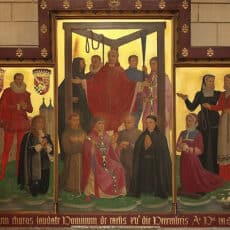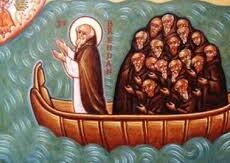The Father of Irish Monasticism
St. Enda of Aran was born in 458, in Rathmore, part of modern-day County Meath. He was the son of Conall Derg, king of Oriel, and Briga, granddaughter of the King of Ard (the Ards Peninsula, County Down).
Both kingdoms were subject to the King of Ulaid, of the O’Neill clan. Interestingly, Enda’s father Conall is the villain in the story of another saint, St. Molasius, who defended his island monastery from Conall with miraculous powers.
Enda had four sisters, Fanchea, Lochinia, Carecha, and Darenia. Despite their father being a warmongering pagan king, all but Darenia became saints. Of particular note is St. Fanchea, who we know the most of besides Enda himself, and who had the greatest impact on his life.
Early in life, Enda followed his father’s ways, though he was described as virtuous and of
good heart, even among his warlike clansmen. After his father died, Enda assumed the throne and became King of Oriel. His sister Fanchea, however, turned down an offer of marriage from another king and became a nun, building an abbey called Rossory Monastery. Fanchea developed a reputation as a holy virgin, but Enda developed a reputation as a warrior-king.
Enda returned from a victorious battle with his clansmen and visited his sister at her abbey, army in tow.
Their exchange is described in detail in The Lives of the Irish Saints:
Fanchea, who had given her heart to resort early to the Lord, hearing the savage shouts of the soldiers, said to the nuns, “This unseemly shouting is not pleasing to Jesus Christ.”
But when she heard the voice of Eanda, she said, “He is a child of the heavenly kingdom.” Fanchea and another nun stood at the monastery gate and when Eanda hastened towards her, she lifted her hand towards him and loudly said, “Do not come near to us, for you are stained with blood.”
Eanda was abashed, and humbly answered, “I am guiltless of bloodshed as well as of all other crimes.”
But she said to him, “Why, wretched man, do you thus provoke God to anger? Why do you drown your soul in a sea of evils by your many sins?”
Eanda answered boldly, “I have the inheritance of my father, and I must fight against my
foes.”
Fanchea said to him, ” Your father is lost, and suffers for his crimes.”
Enda offers to change his ways, but at a price. He wishes to take one of the maiden nuns as his wife. St. Fanchea accepts his offer. As Enda came to see her, however, the nun dropped dead on the spot, declaring her love for Jesus over that of an earthly husband.
Upon seeing her lifeless body, Enda wept bitterly, and his sister Fanchea reminded him of death and judgment comes for us all.
Following through on his promise, Enda forsook all pleasures of the earth and became a
monk. He built a small hut near his sister’s abbey and learned to live a holy life, with her help and instruction.
His fellow warriors, however, were less than amused. They came to convince him to return, but St. Fanchea lifted up her hands in prayer, made the sign of the cross, and their feet fastened to the ground, unable to move. Now, they were both figuratively and literally attached to the world.
In 481, at the bidding of his sister, Enda studied at the monastery of St Paulinius in
Britain then returned to Ireland. Enda came to what is now Cashel in County Tipperary, where his brother-in-law King Aenghus ruled. (Aenghus once sought the hand of St. Fanchea,
who rejected him utterly, causing him to settle for Darenia.) Aenghus wanted to build a monastery for him at the foot of his stone fortress, known today as the Rock of Cashel. Enda begged him to grant him three remote islands off the west coast of Ireland: Inishmore, Inishmaan, and Inisheer.
Enda founded the Killeaney monastery on the island of Inishmore in 490. The monastery grew to become the spiritual center of early Christian Ireland, with over 150 monks living on the islands. The monks of Killeaney emulated the Desert Fathers in their asceticism. Their days were filled with manual labor, prayer, fasting, and study of the Scriptures. They lived alone in stone cells, slept on the ground, and lived mostly off the local shellfish and herbs.
Many Irish saints are associated with Aran.
Over two dozen canonized saints came to the monastic community in Aran to grow in holiness. St. Brendan the Voyager, St. Jarlath of Tuam, St. Finnian of Clonard, and St. Colmcille are among the many saints whose spiritual journeys led them to St. Enda’s monastery.
St. Enda died of old age around 530, and his feast day is March 21. He was buried
in Inishmore. The monastic community that he brought forth lived on and flourished until the Vikings began raiding the coasts of Ireland in the 9th century, after which the monastery was abandoned.
Then, in 1650, Oliver Cromwell and his men destroyed most of the monastery’s
structures to use the stone for fortifications in his conquest of Ireland. The monastic community that once served as the spiritual lifeblood of Ireland, founded by the Father of Irish Monasticism, now survives only in scattered ruins.
What does the life of St. Enda teach us?
St. Enda, along with his sister St. Fanchea, teaches us not just the power and need for conversion in our own lives, but the duty we have towards the conversion of our loved ones. As a pagan warrior-king, Enda led a war path towards his own perdition. It was the intercession of his sister that saved his soul. St. Enda ended up taking his
warrior spirit and applying it to his devotion to Christ. And while we may not explicitly be pagans or bloodthirsty killers, we are all tempted by the evil one towards valuing material goods and honors over God. St. Enda would not have become a saint had it not been for his sister laying down hard truths on him, in an admittedly dramatic and extreme way.
St. Enda’s feast day is well placed, deep in the season of Lent. He and his monks valued hard
penance and fasting. It is no coincidence that this monastic community produced so many saints. We cannot let St. Enda’s example go to waste as Easter approaches. Let us renew our Lenten penance with the same warrior zeal that St. Enda had every day of his life.
St. Enda of Aran, father of Irish monasticism, pray for us!





